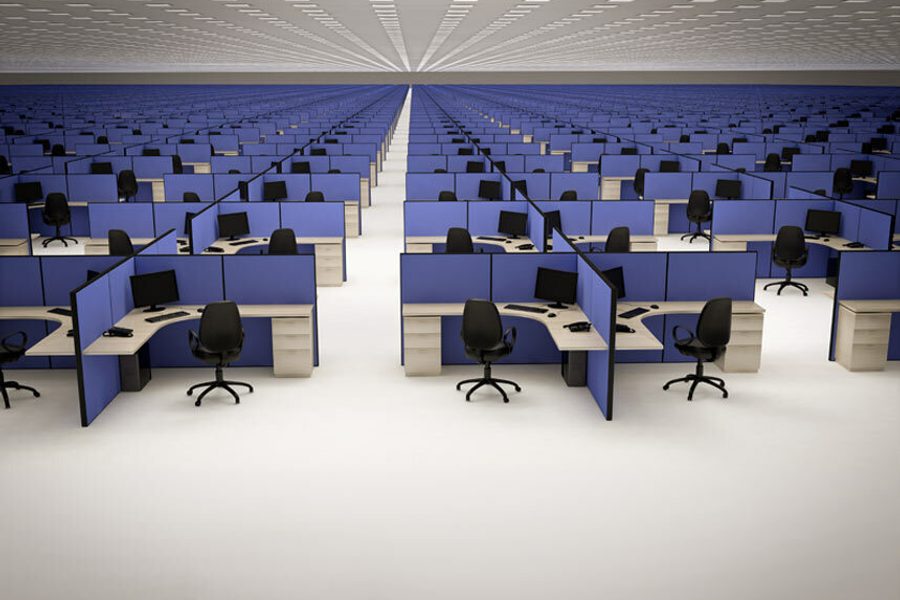A Cubicle of One’s Own
Nikil Saval’s new book, Cubed, shows us the future of the workplace.
Chris Lehmann

It’s odd to come to the end of a sprightly historical tour of the vexed, overplanned world of the modern workplace and realize that the emerging trends are represented by, well, you. Let me explain. In Cubed: A Secret History of the Workplace, Nikil Saval plumbs the management theories and competing design philosophies that produced, in high modernism’s mid-20th century heyday, the arid, soul-crushing, dubiously efficient built environment known as the information workplace. Saval, an editor with n+1, speculates that the lovingly choreographed cubicle-and-corridor organization of work may be consigned to history’s dustbin by today’s knowledge workers. Increasingly, people who toil at the postindustrial processing of data, symbols and information (writers and editors, let’s just say) are making a go of it as casualized, contingent, insecure — or, to use the boosterish euphemisms, “freelance” and “entrepreneurial” — cursors-for-hire. They’ll bypass the traditional perks of office life — the promise of advancement, the allure of job security, health benefits and pension plans — for wiftier virtues such as “autonomy” and “free agency.” These makeshift knowledge workers have burst the surly bonds of the cubicle, and now work at home or in makeshift “co-working” venues carved out of the margins of American life — cafés, home offices or time-share facilities leased with other wayward, laptop-wielding consultants-on-the-fly.
That’s me. I have two editing jobs, which I carry out as a telecommuter. I freelance as a writer, editor and reviewer as my schedule permits. I haven’t worked in an office or attended a meeting in three years. I rent a space — a cubicle, actually — in a writer’s center in my smug little corner of Northwest D.C.
Should the notion strike, I could put my laptop in my bookbag and head across the street, where a half-dozen or so D.C.-to-New York buslines fetch up passengers, and take a field trip. (The bus is just $20, with free wifi, so I can keep working!) Disembarking in Midtown Manhattan, I could tour the skyscrapers that once symbolized the mid-century American determination to render the mundane rites of office work something bright, clean, brave and futuristic. I could take in the Seagram Building on Park Avenue, designed by the German master of the austere monolith Ludwig Mies van der Rohe. I could espy Philip Johnson’s famed Sony Tower, originally commissioned as the headquarters for AT&T. Johnson — the high-modernist fascist sympathizer who reinvented himself as an unlikely apostle of vernacular corporate design — created this riot of clashing architectural styles topped off by a bow-like pair of pinkish Chippendale-style open pediments. It was this ’80s structure, more than any other, that brought the idiotic romance of the “postmodern” into the working lives of ordinary Americans.
As Saval makes clear, our office culture has risen and fallen in tandem with broader currents of social thought, industrial psychology and design innovation. The Sony and Seagram buildings are now rueful monuments to a long-vanished moment in postwar corporate life, when the lords of commerce felt themselves to be the anointed, omnicompetent masters of the universe.
Still, this state of neglect seems fairly benign, when you ponder another specimen of the age: Herman Miller, Inc.’s revolutionary conception of the “Action Office” — a frenetic congeries of standing desks, “movable display surfaces” and open passageways, all painstakingly crafted to induce “fortuitous encounters” among the creative knowledge elite who were supposed to give intellectual life to all the “action” surrounding them. The intention behind the design was very much to convince Miller’s clients that they were poised to conquer the postindustrial future. Robert Propst, a Miller executive and Action Office’s designer and lead propagandist, explained in a manifesto accompanying the release of Action Office II that this office was “a thinking place” and “the real office consumer [was] the mind.” However, Propst’s overheated liberationist rhetoric, like the imperious performance-architecture of Johnson and van der Rohe, concealed a darkness at its heart — a disregard for the needs of the workers that these elaborate designs would house. Propst’s millennial fancies were “unencumbered by personalities and bad behavior,” Saval writes. “His vision is so complete, so penetrating that it refines human need out of existence. He sees only bodily needs, and in his models people are only bundles of mental stimuli.”
“Action Office,” in its first incarnation, was too expensive and too radical for its would-be administrators of the corporate future to adopt. In 1968, the Miller firm debuted a more muted and conventional version whose Hollywood-sequel-style title, “Action Office II,” was another token of the conquering spirit of postwar industrial design. And like all confident bids to annex the future, this one yielded a gruesomely ironic outcome: The most significant legacy of Action Office II is the glum, segmenting, claustral knowledge-worker cubicle. Once the nation’s corporate employers modified the high-concept accessories of Propst’s frenetic reveries of liberated thought exchange into standardized, readily reproducible workstations, they shrank ineluctably into the “veal-fattening pens” immortalized by Douglas Coupland in his 1991 office novel Generation X. The “display surfaces” that promoted the freewheeling exchange of ideas in Propst’s “thinking place” mutated into funereal beige backdrops for Dilbert cartoons and Successory posters — each, in its own way, a desperate protest against the worker’s uncreative confinement. Contrary to Propst’s prophecies, the cubicle-era workplace, rather than treating the mind as its principal consumer, turns the worker’s brain into a resentment-filled warehouse of micromanaged drudgery.
Which leads, in its own cunning-of-history fashion, to my own freelance plight. My work days, split between my home office and my rented cubicle, pass pleasantly enough. I try not to think about my job insecurity and lack of a pension plan as I spin out words like these for my thought-clients (or whatever Robert Propst would call them today were he still with us). Saval, for his part, thinks it’s possible that my own officeless, free-floating working life portends bigger changes:
The willingness of workers to discard status privileges like desks and offices … suggests that the career path that defined the white-collar worker for generations … is coming to a close, and a new sort of work, as yet unformed, is taking its place. It remains for office workers to make this freedom meaningful: to make the “autonomy” promised by the fraying of the labor contract a real one, to make workplaces truly their own.
It appears that I’m part of a revolutionary vanguard. Does that mean I can now stop paying to rent a cubicle of my own?









